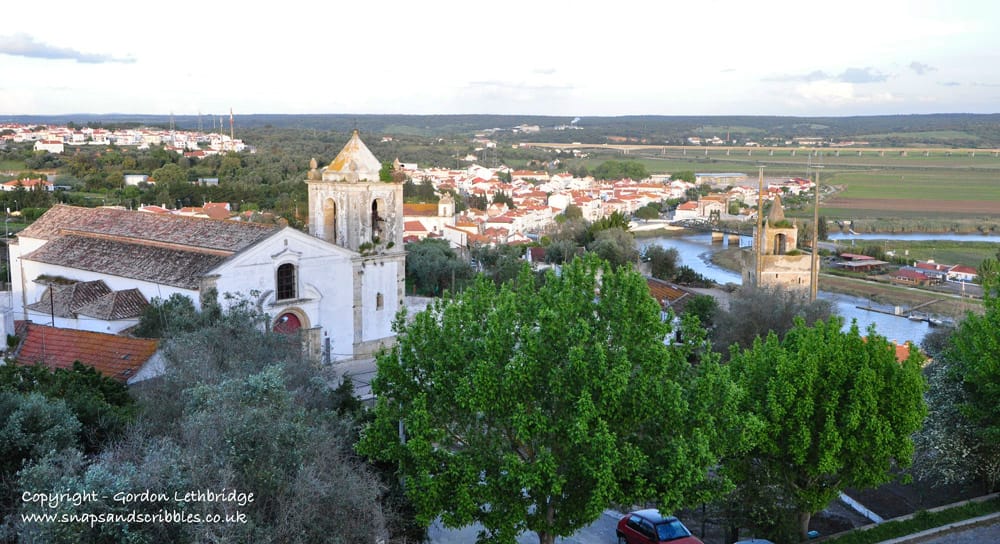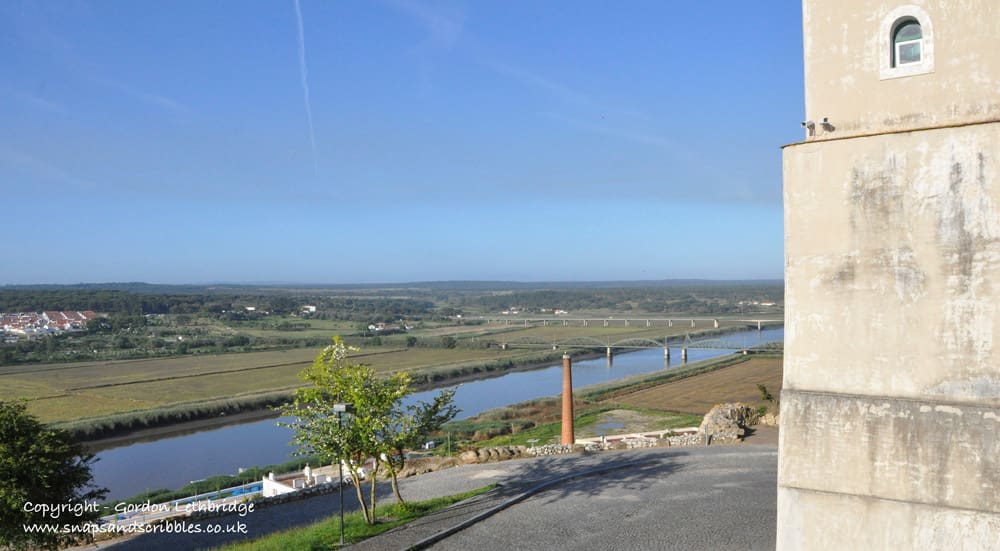From my window high up in the castle and convent Pousada D. Afonso II I gazed across the town of Alcácer do Sal to the river Sado and it’s floodplain. Wisps of mist hung over the river and spilt onto the banks as the morning sun warmed the scene. The pousada, a hotel in the historic buildings of the castle and convent, was built on a hill overlooking the town of Alcácar do Sal. The town’s name gives an indication of the importance of salt to the local economy. I could imagine the gleaming white salt pans stretching into the distance as the tidal river meandered towards the sea on the Alentejo’s west and only coast.

The salt pans are no more though. Taxation and other factors forced the townspeople to look for more profitable products. What had once been salt pans gleaming white in the summer sunshine were now fields of rice stretching like a plush green carpet to the distant hills.

The previous evening I had sat down to dinner with my host. The meal showcased the simple ingredients of Alentejo from which much of the gastronomy of Portugal is derived. The Alentejo is often referred to as “the breadbasket of Portugal” but I prefer the much more romantic and descriptive “gastronomic soul of Portugal”. My host explained that the basis of most dishes in Alentejo is olive oil, garlic or onion and bread. However, they will often feature other common ingredients of the region.

One of these is rice from the very fields I could see from my room. Pine nuts feature strongly in many dishes, both savoury and sweet. The pine trees (pins pinea) from which they are harvested look like green clouds floating above the scrubland of the Alentejo countryside and are known locally as cloud pines.

There are forests of cork oaks that supply cork for much of the world’s wine bottles. The acorns of these trees drop to the ground and are useless for human consumption but allow pigs to forage for them and you have a ready-made supply of acorn-fed pork also known, in Alentejo as black pork.
The soil is very fertile and is used to grow a wide range of fruit and vegetables. Wild asparagus is a popular vegetable accompaniment along with ubiquitous tomato.

Alentejo has a long, wild and rugged coastline interspersed with fantastic beaches and estuaries so fish and seafood feature in much of the region’s cuisine. Sardines, sea bream, anchovies, octopus and cuttlefish are common ingredients along with shellfish. So productive were the waters along the Alentejo coast and estuaries that the Romans set up an industrial scale fish processing plant.

Alentejo is also noted for some of its desserts. Cream and egg are often the main ingredients and popular in desserts together with almonds or walnuts. Honey is produced in the region and is often used to sweeten desserts. Cakes topped with pine nuts and honey or caramel are a popular sweet.

The Alentejo has a wide variety of ingredients and tastes but many of these are seasonal. People in the region since Roman times have lived with this seasonality and place specific products and continue to do so today. On the way, they have been influenced by their invaders and integrated it into their own cuisine. The principle of honest cuisine underpins much of the cuisine of the Alentejo; meaning you will not get out of season food but when you do eat it, in season, of course, it has a genuine taste. A taste that is often location specific.
The Alentejo is now being referred to as the New Tuscany but I that does the Alentejo a disservice. It is far better than Tuscany; it has its own unique cuisine that reflects its own cultural heritage.
The Alentejo’s gastronomy is showcased in a new year-round celebration of authentic local producers and restaurants, the Alentejo Festival of Food and Wine. Each restaurant participating in the scheme has created a special three-course menu that features the regions best ingredients. Visit any restaurant displaying the logo and you will experience a slice of Alentejo’s mouth-watering gastronomic heritage with minimal food miles involved. Sunvil Discovery has tours of Alentejo with a special Festival of Food and Wine booklet listing restaurants, menus and prices. What’s more, the accommodation is carefully selected to be within walking or circling distance of the recommended establishments.
Sunvil Discovery: www.sunvil.co.uk
For more information on the festival and on region visit the Alentejo’s very informative website www.visitalentejo.com
Declaration: I travelled as a guest of Agência de Promoção Turística do Alentejo. As always I retain full editorial control and all opinions are mine.





2 thoughts on “Alentejo, gastronomic soul of Portugal”
Portuguese food and wine are the country’s top attractions! For the readers looking to discover Portugal through its culinary, I recommend using services like WiserGo.com to connect with local experts. They have the insights needed to get you to the right spots.
Thanks for the heads up Pedro. The food of the Alentejo certainly is one of its top attractions. There are more posts to come on the gastronomy theme.
Comments are closed.